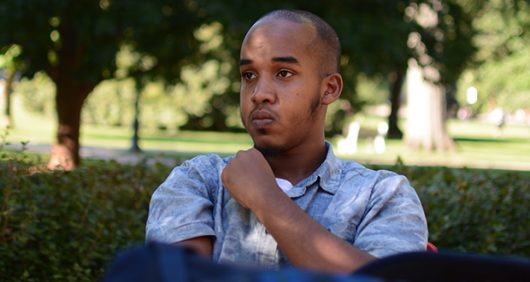
The initial photo of Abdul Razak Ali Artan that appeared in an August issue of The Lantern. Credit: Kevin Stankiewicz | Oller Reporter
Abdul Razak Ali Artan was sitting outside Mendenhall Laboratory before his class on Aug. 23. It was his first day on campus as an Ohio State student. He was sitting alone, staring intently into the distance, when Kevin Stankiewicz approached him.
Stankiewicz, third-year in journalism and Oller Reporter for The Lantern, was working on a weekly print feature in The Lantern called Humans of Ohio State. The feature is modeled after blogger-photographer Brandon Stanton’s “Humans of New York,” in which he interviews and photographs strangers, posting their portraits and snippets of the interview on his blog and social media.
Artan, who identified himself to The Lantern in August as Abdul Razak Artan, was the first subject of Humans of Ohio State when it became a weekly feature this year. On Monday, Artan was identified as the one who attacked OSU students with a vehicle and knife before being shot and killed by police. News outlets have since picked up and shared the Humans of Ohio State feature on Artan.
In the feature, Artan expressed fears over praying on his new campus.
“He was very scared to go out to pray,” Stankiewicz said. “On the Oval, on the first day, he didn’t know what the climate was like here. Paraphrasing, but he specifically mentioned he was afraid someone might shoot him. He just didn’t know if anyone would be intimidated.”
Stankiewicz said Artan came across as genuine and nice. In the interview, Artan listed several instances of Islamophobia that Muslims and refugees have experienced.
“I don’t know what was in his heart, he spoke really softly,” Stankiewicz said. “He did not seem angry.”
Stankiewicz said he was interested in the Humans of Ohio State feature because it shared people’s stories and encouraged empathy.
“We really don’t know enough about each other,” Stankiewicz said.
Hannah Herner — editor of The Lantern’s Arts&Life section, which features the Humans of Ohio State series — echoed Stankiewicz’s sentiments.
“When I was wanting to do (Humans of Ohio State) this fall, I was hoping people would see a familiar face and want to pick up the paper and read it,” said Herner, a fourth-year in journalism. “But there’s also a lot of different people at OSU, and I think that’s the benefit of being at a large university like this. There’s a lot of different people here, and you can relate to them on some level.”
Herner said the format of the feature can be especially powerful.
“(Readers) might not read a whole story, which has real people in it saying real things,” she said. “But when it’s people in their own words saying their own piece, they seem to really respond.”
Artan’s motive remains unknown, but the Humans of Ohio State feature shed some light on his mindset earlier this semester.
“I don’t know what and where and when and why and how, but something happened between Aug. 23 and now,” Stankiewicz said. “A lot of people are injured, and I don’t know what happened.”


